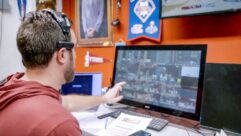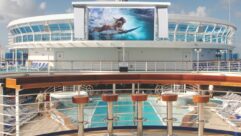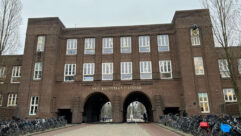
INSTALLATION: Christian Brothers College High School
Mar 24, 2004 8:40 PM
Charles Conte (Writer)
Twin turrets flank the arched main entrance. The octagonal chapel is partly encompassed by the library. Statuary and stained glass windows, reminiscent of the old campus, have their place in the new.
The guidance offices overlook the dining hall, lockers line the hallways, and the new gym has a maple hardwood floor with retractable bleacher seating. But the traditional brick and mortar exterior and the familiar trappings of high schools everywhere hide a high-tech heart.
Students can access resources throughout the facility via the WiFi network.
At Christian Brothers College (CBC) High School in Town and Country, Missouri (in the western portion of St. Louis County), every one of the school’s nearly 1,000 students has his own laptop. They log onto the local network and the Internet without a wire anywhere. Their homework assignments are online. Swipe cards, to be introduced this winter, will be all they need to purchase at the bookstore, buy lunch in the cafeteria or a soda in the snack bar, or check out a library book. Students won’t need cash, keys, or even credit cards. And there’s not a blackboard or a stick of chalk on the whole campus.
The all-boys CBC High School, opened in fall 2003, literally runs on a Wi-Fi network. Students, administration, faculty, and parents are linked in the education process to one another and to the outside world.
For 80 years, CBC occupied a 110,000-square-foot facility Clayton. The new facilities in Town and Country total 245,000 gross square feet on nearly 25 acres: 52 classrooms; 11 specialty classrooms (art room, fine-arts room, biology labs, computer instruction areas, TV production studio); a 3,000-seat stadium; a 380-seat performing-arts center; a 300-seat chapel; a 500-seat dining area; and a 1,800-seat gymnasium.
The new facility is the product of a collaborative effort involving school officials (as well as faculty and students), the project architect (Mackey Mitchell Associates), the general contractor (Alberici Constructors), the technology general contractor (Sonacom of St. Louis), and IT systems contractor Lexiter Technologies.
Docking station for laptop at the teachers’ bi-level podium and desk.

Sonacom played a central role in the $45 million project that included design of the system infrastructure and system specifications: cabling for voice, data, and video; wireless networking options for a local area network (LAN); IP security camera system and security access system; A/V for each classroom and the commons areas; desktop specifications for PCs; and telephone options.
Lexiter Technologies–based in Troy, Illinois, with an office in St. Louis–which had worked alongside Sonacom at CBC HS, took over the contract in December. Lexiter provides a range of computer systems, software, and networking consulting services with special expertise in Microsoft and Cisco infrastructure products. In January 2004, Lexiter President Rick Dalechek Jr. hired two former Sonacom systems designers, Joe King and Todd Bertchume, to complete network installation at CBC HS. “Lexiter has made the whole transition process easier,” says Dr. Kären Engdorf, CBC’s director of technology. “They’ve been superheroes with their capes on.”
A second, St. Louis–based company–SAVI, LLC–stepped in to handle the systems integration portion of the CBC High School project. SAVI offers services that extend from end-to-end A/V systems design-build, to user training and on-site maintenance and warranty service.
“We wanted to maximize technology for collaborative learning,” says John Hutchison, director of finance and operations at CBC. “So we made sure technology was an integral part of the new school’s design and construction.” Nonetheless, with no schools to pattern the systems design after and no similar complete educational technology platforms in use, the systems design team had its work cut out for it–two years of work.
Some 15 percent of the nation’s schools have wireless networks, according to a Market Data Retrieval study. A high-speed, wireless network is easier to implement, especially in existing structures, than a wired network and is considerably less expensive. Far fewer schools issue each student a laptop. Programs in Maine for seventh and eighth graders and Michigan for sixth graders are highly visible and well-funded exceptions. (CBC students lease their IBM laptops through the school for $500 a year.) But few schools, if any, have been built around a high-speed, universally accessible wireless network and the concept of total integration of high-end media and the educational process. “For me it’s a dream come true,” says Engdorf.
Key manufacturers involved in the CBC HS systems are Cisco wireless routers and switches, and VoIP system; Extron video routers; Crestron touch panels for wireless local and remote A/V systems control; Polycom conference phones; Sony LCD projectors; Samsung video components and DVD/VCR; Smart Technologies interactive white boards; IBM T Series laptops with Centrino processors and ElectroVaya batteries; Ashley and Crown audio amplifiers; Symetrix digital-audio mixers; and loudspeakers from Tannoy, installed campus-wide.
Hardcopy and software co-exist in the library.

Systems and Systems Integration
In addition to the traditional systems for any sizeable facility–paging, badging, access control, and CCTV for security–CBC has systems for voice, data, audio, and video running over the network.The tie-in points for many of these systems are the custom-designed teaching stations in each classroom. The teaching station, in fact, is where technology and the curriculum meet and through the laptop or Crestron CT-1000 touch-panel interface. “We use Crestron e-Control to program system so that each individual teaching station and the A/V systems controlled via the touch panels can be monitored and controlled remotely,” says Lexiter President Rick Dalechek. Each teaching station has a Crestron MP2E Ethernet control system and audio/video switcher that provides total control of a room’s multimedia resources: DVD players, projectors, screens, lighting. “The system administrator [Dalechek or the school IT director] can connect over the LAN or from computer anywhere connected to the Internet for local control of the entire system, from the campus level to a building to a room.” Lexiter programmed the control system with a number of automated functions; projectors in each classroom shut down at 5 p.m., for example, conserving expensive bulb life.The phone system is a VoIP system from Cisco via the wireless network. A SymNet digital-audio matrix system mixes, routes, and provides processing for audio from multiple sources and allows for control of everything remotely. The SymNet system operates over a CobraNet system (from Peak Audio) for transporting multichannel audio and control data over the network to the TV studio for recording and broadcast. High-Quality Audio: Voice Intelligibility Is Key
If statistics were available, it’s doubtful one would find many high schools built around the importance of uniformly high-quality audio in every classroom, venue, and common area. In the classroom, as elsewhere but especially in the classroom, voice intelligibility is the critical reason for high-quality audio. Language classes, for example, are built around access to Internet and DVD/CD materials, and other classes draw upon those resources, as well. If students are viewing digital video on a large LCD monitor or projected on white board–or even on their individual laptop screens–the audio delivery system needs to match both the quality and impact of the visual. After all, the classroom competes for students’ attention with more than 30 million home-theater systems in U.S. households. Custom Teaching Stations
A committee made up of teachers, school administrators, the architect, and technology teams tackled the issue of a teaching station: the single spot where the curriculum truly intersects with technology. The old oak teacher’s desks are gone. In their place are bilevel teaching podiums in each classroom that offer audio, video, Internet, phone, and security access, as well as a traditional workspace. Multimedia control is from either laptop computer (that slips into a docking station) or from a Crestron CT-1000 touch panel embedded in the teaching station surface itself. The Crestron interfaces with a cable-TV connection, a Sony VPL-PX11 LCD projector (to a 72-inch Smart interactive white board that allows access and control of any application projected from a laptop source), a document camera, a Samsung DVD-R, and a VCR. Audio/video sources and the laptop are tied to the in-ceiling loudspeaker system. The A/V components in each classroom are housed in an equipment closet and connected through a conduit connected to the teaching stations. (Teachers also have access to high-resolution security cameras throughout the building, running MPEG4 over the network for the CCTV system.)”The teaching station now in use is actually the third prototype developed from our demo room experience,” says Engdorf. “Some teachers wanted to use a podium, while others wanted to sit down. So we combined both podium and desk levels in one unit and designed the cable infrastructure to go through the desk to the docking station. The drawers are short in order to protect that cabling in back but are deep for storing CDs and DVDs.” Other simple features–a V-mute button, for example, programmed onto the touch panel so teachers can blacken the screen in order to get students’ attention–“we managed to work out in the demo room experience,” says Endorf, “and by using an online survey tool to elicit hard data to show us exactly what we needed to put into the classrooms.”Audio in the classrooms receives special attention. “The kids sit up and take notice,” says Staggenborg. “One teacher said to me, ‘I’d rather give up some of the technology aids before I’d give up the audio system.’ To me the message is clear: don’t skimp when it comes to a classroom audio system.”
The Tannoy PowerLinx systems in the classrooms are self-contained: a 100W (110TB) active ceiling subwoofer and four CMS65 1X2 ceiling monitors. Ashley amps drive five of the six audio subsystems, and Crown CT-series amps drive the stadium and paging system. A SymNet system (network-linkable audio matrix digital signal processors from Symetrix) with a CobraNet (from Peak Audio) interface provides local control of the seven nonclassroom audio systems. The choice of ceiling monitors versus wallmounted, architectural loudspeakers was based on ease of installation and the fact that they are less visible and, hence, less likely to attract the attention of someone looking to build a home surround-sound system on the cheap.In a school, you don’t typically have high-end audio personnel on staff. So every mic input on each of the school subsystems is live; that is, hot-connected to the SymNet matrix in each venue, and different configurations were established for each system that the operators can choose from. Each venue, including the classrooms, was modeled using EASE acoustic modeling software from Acoustic Design Ahnert.Demo Room: A Good Place to Start
In March 2003, the systems design project team started developing solutions for delivering audio/video and data to each classroom and for wireless networking options for a LAN. The construction team for the new school came together and gutted a 25-by-30-foot classroom on the old campus to make way for a demo room to test available technologies, hardware, and software.The advantages of a demo room became apparent almost immediately. First and foremost, the room became a training ground to allow students, faculty, and administrators to become familiar with the wireless environment and systems they would be using in the new school. The demo room gave the design team and CBC the opportunity to test monitors versus projectors, button control panels versus touch screens, and different types of electronic white boards, laptops, batteries, and software in an actual classroom setting instead of on a showroom floor.Although the most advanced products available were used, the system as a whole consists primarily of off-the-shelf, proven hardware and software. However, one of the numerous pieces of the technology puzzle that came together at this stage was a solution to keeping the 1,000 student laptops and faculty laptops charged all day.A Canadian firm became important here: ElectroVaya, which designs a thin rectangular battery that fits under the laptop’s base. Coupled with the new Centrino energy-saving processors in the IBM T Series laptops, the CBC laptops have been field-tested to hold a charge for up to 21 hours, versus the 3 to 4 norm for standard lithium-ion batteries. Beyond its value as a testing ground for equipment, the $50,000 demo room saved CBC time and money–an estimated several hundred thousand dollars, in fact. And the demo room provided working knowledge on more than just specific technical issues. The contractor and architect also benefited from the demo room. Lighting, blinds, desks, teaching stations, chairs, and podiums: all changed from their initial concepts because the students and faculty were able to test them out. CBC was able to wrap building features around technology instead of the other way around. The demo room proved so valuable that a similar room was set up in the new main building that will allow CBC to continue to test equipment, integrate new technologies, and determine what works best in the classroom environment.A Work in Progress
CBC High School is a fully functioning, state-of-the-art educational institution. But that does not mean it will not continue to evolve. Plans are to build to build a TV production studio this summer that will rival similar facilities on college campuses. The facility will be available for students in fall 2004, says Staggenborg. The school will also expand its course offerings in the areas of video production and Webcasting. The future looks bright for CBC High School. In fact, it’s not the future at all. It’s here and now.KEY MANUFACTURERS
Ashly signal processing and mixers
AKG microphones
Audio-Technica microphones
Cisco wireless routers and switches and VoIP system
ClearOne document cameras
Crestron touch panels for wireless local and remote A/V systems control
Crown audio amplifiers
Da-Lite video screens
Dell computers
Digital Monitoring Products access control
DPA microphones
DVTel network video recording systems
ElectroVaya laptop batteries
Extron video routers and switches
Gepco audio and video cabling
IBM laptop computers
Lowell Manufacturing system racks
Mackie mixing consoles
Maxxis security system access control
Pelco video security equipment
Polycom videoconferencing cameras
Radio Design Labs
R. L. Drake CATV system
Samsung DVDs and VCRs
Smart Technologies interactive white boards
Sony LCD projectors
Staco power transformers and conditioners
Symetrix digital-audio mixers
Tannoy loudspeaker systems









